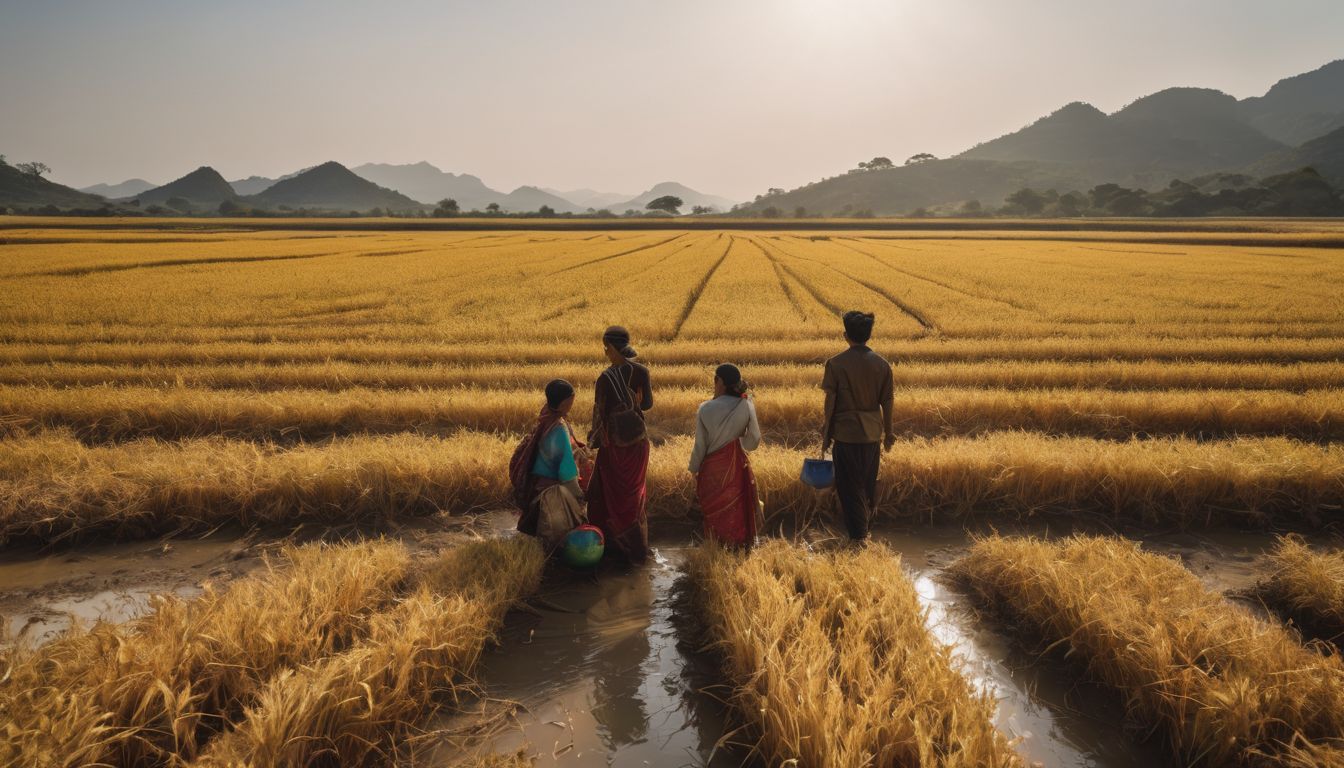Climate change isn’t just about weather; it’s changing our lives too. By 2050, up to a billion people could be displaced because of rising sea levels and extreme weather. This article explores the deep social impacts, from lost homes to vanishing jobs, and offers ideas for positive action we can all take.
Read on – it affects us all.
Key Takeaways
- Rising sea levels and extreme weather could displace up to a billion people by 2050, with vulnerable communities facing the greatest risks.
- Indigenous peoples’ livelihoods and cultures are under threat as climate change disrupts traditional practices and natural resources they depend on.
- Urban populations suffer from worsened air quality, increased illnesses, and inadequate water supply due to rising temperatures and infrastructure strain.
- Employment in industries such as agriculture, forestry, and fishing is being shaken by environmental shifts, requiring sustainable job creation strategies.
- Education about climate change needs integration into school curriculums to empower younger generations for future environmental challenges.
Impacts of Climate Change on Vulnerable and Marginalised Communities
Vulnerable and marginalised communities are disproportionately affected by climate change due to their geographic location, with Indigenous peoples and urban populations at higher risk.
Climate change also has detrimental effects on the health, employment, and education of these communities.
Geographic location
Geographic location plays a critical role in determining the impact of climate change on communities. People living in low-lying coastal areas face an increased risk of devastating floods and storm surges as sea levels rise.
Those residing in arid or semi-arid regions grapple with harsher drought conditions, threatening their water supply and agriculture. In urban settings, the heat island effect intensifies sweltering temperatures, affecting health and increasing energy demands for cooling.
Communities located near polar regions are witnessing drastic changes to their way of life as ice melts at unprecedented rates. This melting reshapes landscapes, alters wildlife migration patterns, and impacts local fishing industries heavily dependant on cold environments.
Furthermore, islands and countries within the tropical belt are more likely to experience extreme weather events like hurricanes and typhoons that can wipe out homes and infrastructure overnight.
Each geographic area carries its own set of challenges requiring tailored approaches to climate adaptation and mitigation strategies by stakeholders committed to fostering community resilience against environmental effects related to global warming.
Indigenous peoples
Indigenous peoples are particularly vulnerable to the impacts of climate change due to their close connection with the environment and reliance on traditional practices. Their livelihoods, cultural heritage, and health are at risk from changes in weather patterns, loss of biodiversity, and environmental degradation caused by global warming.
Climate-related events such as droughts and floods can directly impact Indigenous communities, leading to food insecurity and displacement. It is essential to incorporate Indigenous knowledge into climate change adaptation strategies and ensure their active participation in decision-making processes for sustainable solutions.
Protecting the rights and territories of Indigenous peoples is crucial in addressing the social consequences of climate change. Collaborative efforts between governments, organisations, and local communities can help safeguard Indigenous lands, preserve traditional ways of life, and promote resilience against environmental disruptions.
Urban populations
Urban populations are significantly impacted by climate change. Rising temperatures worsen air quality, leading to increased respiratory illnesses among city dwellers. Extreme weather events, such as heatwaves and flooding, pose risks to infrastructure and public health in urban areas.
Additionally, the strain on water resources could exacerbate existing challenges related to access to clean water and sanitation within cities. This environmental impact can disproportionately affect low-income communities who often bear the brunt of the effects of climate change.
Moreover, economic disparities within urban settings can make it challenging for some populations to adapt or recover from climate-related disruptions. The allocation of resources and infrastructure development play a crucial role in determining how various communities will be affected by these changes.
Health
Climate change has a significant impact on human health, leading to increased heat-related illnesses, respiratory problems due to air pollution, and the spread of infectious diseases.
Vulnerable populations are most at risk, including those living in poverty and with limited access to healthcare. The effects of global warming also exacerbate social inequalities, affecting marginalised communities disproportionately.
It is crucial for environmentally conscious individuals and supporters of conservation efforts to understand the direct link between climate change and public health. By addressing the health impacts of global warming through sustainable actions and policies, we can work towards building a healthier future for all.
Employment
Climate change has significant implications for employment, particularly in sectors vulnerable to environmental impacts such as agriculture, forestry, and fishing. As extreme weather events become more frequent, there are increased risks to job security and livelihoods in these industries.
Moreover, shifts in ecological systems due to climate change can also impact employment opportunities – not only causing job losses but potentially altering the types of work available.
It’s essential for businesses and governments to develop strategies that support workers affected by climate-related changes while also promoting sustainable and resilient job creation.
Education
Communities must understand the impacts of climate change on education. Rising temperatures can affect school attendance and productivity, particularly in areas prone to extreme heat.
Additionally, natural disasters like floods and wildfires can disrupt learning environments and infrastructure, amplifying challenges for students in vulnerable regions. The curriculum should incorporate climate change education to promote awareness and empower future generations with the knowledge to address environmental issues.
Engaging young people in sustainable practices is crucial for building a resilient society capable of mitigating the effects of global warming.
Furthermore, investing in educational resources for marginalised communities will be vital to ensure equal access to information about climate change adaptation and resilience strategies.
Effects of Climate Change on Economic Activities and Services
Climate change has significant impacts on economic activities and services, leading to disruptions in infrastructure, energy production, agriculture, tourism, and various other industries.
These effects can have far-reaching consequences for businesses and the economy as a whole.
Infrastructure and buildings
Climate change poses significant challenges to infrastructure and buildings, leading to increased risks of damage and disruption. Rising sea levels can threaten coastal structures, while extreme weather events, such as hurricanes and heavy rainfall, can result in structural damage.
Additionally, higher temperatures put pressure on transportation systems and energy infrastructure. The need for climate-resilient buildings and sustainable urban planning has become increasingly urgent to mitigate these impacts.
The effects of climate change on infrastructure are far-reaching; they affect not only the physical structures but also essential services like water supply, sanitation, and healthcare facilities.
Energy
Energy production and consumption are significantly impacted by climate change. The rising temperatures can affect the efficiency of power plants and transmission lines, leading to potential energy supply disruptions.
Changes in precipitation patterns can also impact hydroelectricity generation, affecting the reliability of renewable energy sources. Furthermore, extreme weather events such as storms or floods can damage energy infrastructure, leading to power outages and causing significant economic and social disruption.
The transition towards sustainable and low-carbon energy sources is crucial for addressing the social consequences of climate change. Investing in renewable energy technologies like solar and wind power can reduce greenhouse gas emissions while enhancing energy resilience.
Agriculture and forestry
Climate change has been disrupting agriculture and forestry, threatening food security and the livelihoods of communities. Rising temperatures and extreme weather events have caused shifts in growing seasons, impacting crop yields and quality.
Droughts have become more frequent, reducing water availability for irrigation and increasing the risk of wildfires that damage forests. Changing climate patterns also affect pests and diseases, posing significant challenges to crop management.
As a result, farmers are forced to adapt their practices to cope with these challenges, which often requires additional resources and investments. Meanwhile, forestry is facing increased pressures from deforestation as well as changing forest ecosystems due to temperature changes.
These impacts not only affect local economies but also contribute to global concerns about sustainable resource management.
Insurance
Insurance companies are adapting to the changing landscape of climate-related risks. They are developing new insurance products to cover extreme weather events and property damage caused by climate change.
By adjusting their risk models, insurance companies can provide better coverage for individuals and businesses affected by the impacts of global warming. Implementing innovative solutions like parametric insurance can ensure faster payouts in case of natural disasters, helping communities to recover more quickly.
As climate change continues to impact vulnerable populations and economic activities, it’s crucial for insurance companies to stay ahead of these changes. Finding ways to mitigate risk through proactive measures will be essential for protecting both individuals and businesses from the social consequences of climate change.
Tourism
Tourism is significantly impacted by climate change. The changing weather patterns and natural disasters can disrupt travel plans, affecting popular tourist destinations. Extreme heatwaves, hurricanes, and rising sea levels pose threats to coastal resorts and attractions.
Additionally, environmental degradation due to climate change can deter tourists who seek pristine landscapes and natural beauty. The decline in tourism not only affects the local economy but also contributes to social inequality within communities that depend on tourism as a major source of income.
Furthermore, the environmental consequences of tourism exacerbate the effects of climate change. Air travel emits significant amounts of greenhouse gases, contributing to global warming.
Cross-cutting issues for businesses
Tourism contributes significantly to the economy, but businesses are also grappling with cross-cutting issues related to climate change. Rising temperatures and natural disasters affect supply chains, production, and distribution networks.
Companies must adapt by implementing sustainable practices to mitigate environmental impact.
Businesses must anticipate the effects of climate change on vulnerable communities and economic activities for long-term sustainability. Regulatory changes may impact operations, urging companies to embrace renewable energy sources and invest in resilience strategies.
Consequences of Climate Change on Natural Systems
Climate change leads to high temperatures, droughts, wildfires, floods, sea-level rise and loss of biodiversity. Want to learn more about the impact on natural systems? Read on!
High temperatures
High temperatures increase the risk of heat-related illnesses and can be particularly dangerous for vulnerable populations, such as the elderly, children, and those with existing health conditions.
Rising temperatures also contribute to more frequent and severe heatwaves, which can have serious public health impacts.
Extreme heat events can lead to reduced agricultural productivity due to crop damage and livestock stress. Additionally, high temperatures can strain energy resources as demand for air conditioning rises, putting pressure on power grids and increasing electricity costs for consumers.
Drought and wildfires
Following the threat of high temperatures, droughts and wildfires have become more frequent due to climate change. Drought impacts agriculture and access to fresh water, making it challenging for vulnerable communities.
Wildfires pose risks to biodiversity, infrastructure, and human settlements. Addressing these challenges requires collective action and sustainable land management practices.
Rising temperatures exacerbate drought conditions leading to water scarcity while also creating ideal conditions for wildfires. Communities need support in adapting to these increasingly common natural disasters.
Availability of fresh water
Climate change has a significant impact on the availability of fresh water. Rising temperatures lead to changes in precipitation patterns, causing droughts in some regions and floods in others.
These changes affect the quantity and quality of freshwater sources, leading to scarcity that can exacerbate existing social inequalities and create health risks for vulnerable populations.
Communities that rely on freshwater ecosystems for their livelihoods are particularly at risk, as reduced water availability impacts agriculture, fisheries, and access to clean drinking water.
Floods
Floods occur when heavy rainfall or rapid melting of snow leads to an overflow of water onto land, often causing extensive damage to communities and infrastructure. Rising sea levels and extreme weather events are exacerbating the risks of flooding in many regions across the globe.
As a result, vulnerable populations face increased threats to their homes, livelihoods, and safety. Floods also lead to contamination of freshwater sources and pose significant health hazards due to the spread of waterborne diseases.
The impacts of floods on societies extend beyond immediate physical damage, affecting mental well-being and social cohesion. Moreover, businesses suffer economic losses from disrupted operations and damaged assets due to floods.
Sea-level rise and coastal areas
Rising sea levels are increasingly threatening coastal areas, putting communities and ecosystems at risk. With the melting of polar ice caps and glaciers due to global warming, sea levels continue to rise, leading to erosion of coastlines, loss of habitats for marine life, and increased risk of flooding in low-lying areas.
As ocean waters encroach further inland, there’s a growing concern for the displacement of people living in these vulnerable regions. Rising seas also exacerbate saltwater intrusion into freshwater sources, impacting agriculture and drinking water supplies.
The need for proactive measures to protect coastal areas from rising sea levels is urgent. Implementing sustainable coastal management strategies and investing in nature-based solutions can help mitigate the adverse effects on both human communities and natural habitats.
Biodiversity
As we consider the challenges presented by sea-level rise and coastal areas, it’s essential to take stock of the impact on biodiversity. Climate change poses a significant threat to the world’s rich array of plants, animals, and ecosystems.
Rising temperatures, changes in precipitation patterns, and extreme weather events are leading to habitat loss and disruptions in natural cycles. These shifts are endangering countless species and altering entire ecosystems.
Protecting biodiversity is not just an environmental concern but also vital for human survival as it underpins key services such as food production, clean water provision, and climate regulation.
Preserving our planet’s biodiversity necessitates urgent action from all sectors of society; without effective measures to combat climate change and conserve natural habitats, we risk irreversible damage to global ecosystems.
Social Threats Posed by Climate Change
Climate change poses serious threats to public health, particularly for vulnerable populations. It also increases the risk of social inequalities and economic disruptions, impacting communities around the world.
Health impacts
Climate change poses significant health impacts, particularly for vulnerable populations. Rising temperatures contribute to heat-related illnesses and exacerbate respiratory conditions.
Furthermore, changes in precipitation patterns can lead to waterborne diseases and malnutrition. Additionally, extreme weather events can cause physical injuries and mental health issues such as anxiety and post-traumatic stress disorder.
These health concerns disproportionately affect marginalised communities, including indigenous peoples and those living in urban areas with inadequate access to healthcare services.
The effects of global warming on human health are wide-ranging, from the spread of infectious diseases to an increased risk of food insecurity. Addressing these challenges requires proactive measures such as enhancing public health infrastructure, implementing early warning systems for extreme weather events, and promoting sustainable urban planning that prioritises green spaces and air quality.
Vulnerable populations
Climate change disproportionately affects vulnerable populations such as low-income communities, the elderly, and children. These groups often lack the resources to adapt to extreme weather events or relocate from areas at risk of environmental hazards.
Additionally, indigenous peoples and minority communities are particularly susceptible due to their reliance on traditional livelihoods closely tied to natural ecosystems. The impacts of climate change exacerbate existing social inequalities, leading to compromised health, displacement, and economic hardship.
Protecting vulnerable populations requires targeted policies and initiatives that address their specific needs in the face of climate-related challenges. This includes equitable access to climate-resilient infrastructure, healthcare services, and educational opportunities.
Threats to business
Businesses face significant threats from climate change, including damage to infrastructure and supply chains. Extreme weather events, such as hurricanes and floods, can disrupt operations and lead to financial losses.
Rising temperatures also impact productivity in sectors like agriculture and construction. Insufficient access to water resources can hinder production processes while increased insurance costs affect the bottom line for businesses across various industries.
Furthermore, shifting consumer preferences towards environmentally friendly products may compel companies to adapt or risk losing market share.
Economic stability is at risk due to climate-related impacts on business activities. Decreased profitability stemming from higher costs of production may necessitate adaptation measures for sustained growth and competitiveness within a changing market landscape.
Ways to Address the Social Consequences of Climate Change
To address the social consequences of climate change, it is important to take proactive climate action, promote social sustainability and inclusion, address economic inequalities, protect marginalised communities, support adaptation and resilience efforts, and collaborate with communities and stakeholders.
This requires a coordinated effort from individuals, governments, businesses, and organisations to mitigate the impacts of climate change on society.
Climate action
Addressing environmental consequences requires proactive climate action. Encouraging sustainable practices and reducing carbon emissions are vital steps in mitigating the effects of global warming.
Promoting renewable energy sources, such as solar and wind power, plays a crucial role in combating climate change by reducing reliance on fossil fuels.
Engaging in reforestation projects to offset carbon emissions and protect biodiversity is essential for environmental conservation. Supporting policies aimed at reducing greenhouse gas emissions from industries and transportation sectors fosters a healthier environment for all living beings.
Promoting social sustainability and inclusion
To promote social sustainability and inclusion, it is crucial to ensure that all members of the community have equal access to resources and opportunities. This involves advocating for policies that prioritise social justice and equity, as well as supporting initiatives aimed at empowering vulnerable populations.
By fostering a sense of belonging and involvement within communities, we can work towards creating a more inclusive society where everyone has a voice in decision-making processes.
Encouraging collaboration with local stakeholders, including marginalised groups, is essential for developing strategies that address the diverse needs of different communities. It also involves promoting education and awareness about climate change impacts on social systems and inspiring collective action to build resilience against its effects.
Addressing economic inequalities
To address economic inequalities exacerbated by climate change, proactive measures such as investing in clean energy and sustainable infrastructure are crucial. Promoting green job opportunities and providing training for individuals in vulnerable communities can create more equitable access to employment.
Additionally, implementing policies that support fair wages and worker protections within environmentally-friendly industries is essential. By prioritising economic equity within climate action strategies, we can work towards a more inclusive and sustainable future for all.
Furthermore, advocating for financial assistance and resources to support marginalised communities in adapting to the impacts of climate change is vital. This includes ensuring access to affordable insurance options and developing targeted funding initiatives aimed at enhancing resilience in areas disproportionately affected by environmental challenges.
Protecting marginalised communities
As climate change disproportionately affects vulnerable and marginalised communities, it is crucial to implement proactive measures to protect these populations. This includes ensuring access to resources such as clean water, healthcare, and educational opportunities.
It also involves addressing social inequalities and promoting inclusive policies that consider the specific needs of these communities. Additionally, supporting adaptation and resilience initiatives tailored to the unique challenges faced by marginalised groups is essential in fostering long-term sustainability within these communities.
To safeguard marginalised communities from the adverse effects of climate change, active collaboration with local stakeholders is imperative. By engaging directly with these populations and incorporating their perspectives into decision-making processes, more effective strategies can be developed to mitigate the social consequences of environmental shifts.
Supporting adaptation and resilience
Communities must adapt to climate change by developing strategies to withstand its impact. Promoting resilience involves building infrastructure that can endure extreme weather events and ensuring access to resources like food and water.
It also means supporting individuals’ mental health as they cope with new challenges, both physical and emotional. By collaborating closely with communities, stakeholders, and experts, we can develop effective adaptation measures that protect the most vulnerable populations.
In addition to adapting infrastructure and resources, it’s crucial for societies to build adaptive capacity within their communities. This includes educating people on how to respond during emergencies and preparing them for potential disruptions in their daily lives.
Collaborating with communities and stakeholders
Society must join hands in addressing the impacts of climate change. Engaging with local communities and stakeholders is crucial for implementing effective solutions. Partnering with indigenous peoples, urban populations, and businesses to adapt to environmental shifts ensures equitable safeguarding against societal consequences of global warming.
Collaboration fosters inclusive strategies that protect vulnerable populations from health threats while promoting resilient infrastructure and economic activities.
Implementing mitigation strategies collaboratively is key to addressing social inequalities aggravated by climate change. Involving diverse stakeholders in decision-making processes promotes shared responsibility for protecting natural systems and adapting to environmental challenges.
Conclusion
In conclusion, addressing the social consequences of climate change is imperative. Promoting social sustainability and inclusion can help create resilient communities. Collaborating with stakeholders to support adaptation and mitigate impacts is essential for a sustainable future.
Taking proactive steps now will help protect vulnerable populations and build a more equitable society where all can thrive.
FAQs
1. What are the social consequences of climate change?
The social consequences of climate change include health effects from global warming, increased social inequality, economic challenges for communities and a rise in climate refugees due to environmental impacts.
2. How does climate change affect vulnerable populations?
Climate change has severe impacts on vulnerable populations by exacerbating economic struggles, threatening their health, and challenging their ability to adapt and survive in changing environments.
3. What can we do to address social inequality linked with climate change?
To tackle social inequality arising from climate-related issues, it’s crucial to focus on fair mitigation strategies and enhance social justice by protecting the most affected communities through targeted support and resources.
4. Can society adapt to the changes brought on by the climate crisis?
Yes, through developing effective adaptation strategies that improve societal resilience, communities can better cope with the ecosocial consequences of the ongoing climate crisis.
5. Are there any solutions for those forced to migrate due to environmental changes?
Supporting efforts towards mitigating the effects of global warming is vital; additionally providing resources for relocation and securing fundamental rights are key steps in assisting those who become ‘climate migrants’.





